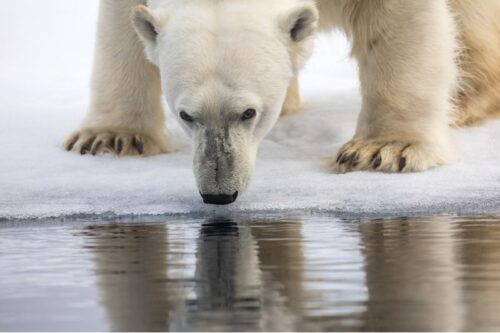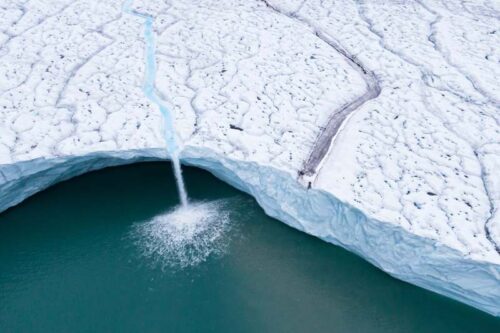Wondering about the best time of year to visit the Arctic? You're in for an incredible journey! This extraordinary polar wilderness offers completely different experiences depending on when you visit. Picture yourself watching polar bear cubs take their first wobbly steps on sea ice, or witnessing magnificent whales breach in crystal-clear Arctic waters - timing your visit right can transform a great trip into the adventure of a lifetime.
The Arctic undergoes amazing seasonal transformations throughout the year, each offering its own unique magic. Let's explore what makes each season special so you can choose the perfect time for your Arctic adventure.
Spring in the Arctic: April to June

Spring is when the Arctic truly comes alive! As temperatures start to warm and daylight hours stretch longer, you'll witness the region awakening from its winter sleep with some of the most exciting wildlife activity of the year.
What You'll See: Spring is nature's nursery in the Arctic. Adorable ringed seal pups are born on the ice, creating perfect hunting opportunities for polar bears - which means fantastic viewing for you! The bears are incredibly active during this time, giving wildlife enthusiasts and photographers some of the best opportunities you'll find anywhere.
You'll also be amazed by the bird life. Thousands of migratory birds return home, including charming puffins, graceful Arctic terns, and bustling guillemots. Watching these massive flocks arrive is truly something special.
What to Expect Weather-Wise: Spring temperatures hover between -20°C to -5°C (-4°F to 23°F), which might sound chilly, but you'll find the weather becomes more predictable as the season progresses. The ice remains sturdy enough for safe wildlife watching while showing those first magical signs of the seasonal thaw.

Summer in the Arctic: July to August
Summer is when the Arctic shows off its most welcoming side! This is the warmest season (though still delightfully crisp), transforming the landscape into something completely different from what you might expect.
Wildlife Paradise: Get ready for whale watching like nowhere else on Earth! The ice-free waters become a highway for beluga whales, mysterious narwhals with their unicorn-like tusks, and massive bowhead whales. Taking a boat trip to see these gentle giants up close is absolutely unforgettable.
Don't miss the walrus gatherings along the coastlines—imagine hundreds of these massive marine mammals lounging together on beaches! Meanwhile, fluffy musk oxen roam the colorful tundra, and you might spot Arctic foxes darting across the landscape.
The Magic of Midnight Sun: Here's something truly extraordinary - the sun never sets! You'll have 24 hours of daylight to explore, photograph, and marvel at the Arctic's wonders. It's like having nature's own extended golden hour.
Perfect Weather: Summer temperatures range from -5°C to 10°C (23°F to 50°F), making this the most comfortable time for Arctic adventures. With less ice coverage, you'll have access to incredible remote locations that are simply unreachable during other seasons.
Autumn in the Arctic: September to October
Autumn is like watching nature's grand preparation for winter - it's a time of incredible change and bustling animal activity that's fascinating to observe.
What Makes Autumn Special: This is when polar bears get seriously busy! They're working hard to build up their fat reserves before winter, which means you'll often see them actively hunting and fishing. It's an amazing opportunity to witness these powerful predators in their natural element.
You'll also witness one of nature's most spectacular events - the great bird migration. Watching thousands of Arctic birds begin their journey south is both breathtaking and slightly bittersweet. The sheer scale of these migrations will leave you in awe.
Adventure with a Side of Unpredictability: Autumn weather keeps you on your toes! Temperatures drop quickly and ice starts forming again, which means every day can bring something new. While this requires flexible travel plans, many visitors find the constantly changing landscape absolutely captivating.

Winter in the Arctic: November to March
Winter in the Arctic is not for the faint of heart - it's an extreme season that challenges even the most adventurous travellers. But for those brave enough to venture north, it offers some truly magical experiences you simply can't find anywhere else.
Unique Winter Wonders: The star of winter is undoubtedly the aurora borealis - the Northern Lights dance across the sky in brilliant greens, purples, and blues during those long polar nights. It's absolutely mesmerising and worth every shiver!
You'll also encounter some charming winter residents. Arctic foxes sport their gorgeous fluffy white coats, looking like adorable snow angels as they hunt across the landscape. Snowy owls become active hunters, and you might even spot a polar bear, though they're trickier to find in the darkness.
What You Need to Know: Winter Arctic travel is definitely an adventure for experienced travellers. You'll need serious cold-weather gear and a good sense of adventure, as most tour operators run limited programs focusing on aurora viewing and cultural experiences with local communities.
Finding Your Perfect Arctic Adventure
So, which season calls to you? Here's how to match your interests with the ideal time to visit:
Polar Bear Lovers: Late spring through early summer (May-July) gives you the perfect combo of active bears and great viewing conditions.
Whale Watchers: Summer months (July-August) are absolutely unbeatable for marine wildlife encounters.
Photography Enthusiasts: Summer's endless daylight creates dream conditions for photographers, while spring offers those dramatic ice formations with active wildlife.
Crowd Avoiders: The shoulder seasons (late spring and early autumn) give you fantastic wildlife viewing without the summer rush.
Budget Travellers: Early spring and autumn often feature better pricing while still delivering incredible wildlife experiences.

Getting Ready for Your Arctic Journey
No matter which season you choose, a successful Arctic adventure needs some thoughtful preparation:
Dress for Success: Layer up with insulating materials, invest in a quality waterproof shell, and don't skimp on Arctic-rated gloves and boots - trust us, your fingers and toes will thank you!
Book Early: Arctic expeditions fill up fast because space is limited. The sooner you book, the better your chances of snagging your preferred dates.
Stay Flexible: Arctic weather has a mind of its own, so embrace the adventure! Sometimes the most unexpected moments become the most memorable.
Health Check: Chat with your doctor about cold-weather travel, especially if you have any health concerns.
Conclusion: Is There A Best Time of Year to Visit the Arctic for Wildlife Watching?
Every season in the Arctic offers something absolutely magical, whether you're drawn to summer's whale-filled waters, spring's adorable seal pups, or winter's dancing Northern Lights. The best time of year to visit the Arctic really comes down to what makes your heart race with excitement.
Take time to plan thoughtfully, prepare well, and get ready for an adventure that will change how you see our amazing planet. The Arctic is waiting to show you wonders you never knew existed -you just need to decide which season's magic speaks to you most! Contact us today to find out more, and plan your trip of a lifetime!